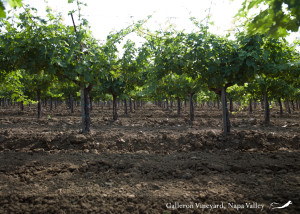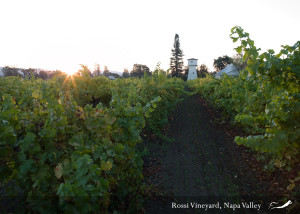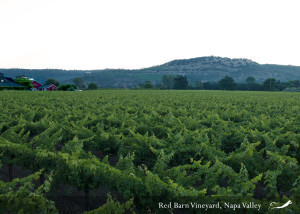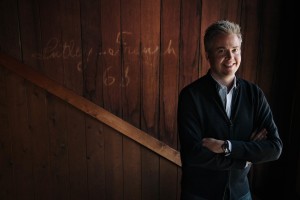Today we have a guest post from Jonah Beer, the Vice President of Winery Operations at Frog’s Leap. Jonah tells us about his “Thinking Like a Grapevine” session at SWE’s upcoming Annual Conference.
Grapevines are living, sentient beings with their days and nights consumed by concern for vital life choices. Critical choices like: when to color and sweeten their fruit to attract birds in order to spread their seed, or when to break bud in the spring, or when to start storing energy for the next season. These are critical decisions a vine makes each and every day.
So how does a grapevine make these decisions? They do so by taking information from their environment. They measure the angle of the sun, the phase of the moon, the tug of the planets, the temperature and moisture content of the soil and the kind of chemical signals soil organisms are giving off. It knows when the birds visit, it’s on familiar terms with surrounding insects and their life stages, and it takes a cue from the acorns falling off the nearby oaks. In short, everything in its environment is a clue.
But what happens so often in most modern-day vineyards? The vines are lined up, their branches forced into restrictive trellising and their growing tips are cut off. They are exposed to toxic pesticides and fed strong, synthetic fertilizers. They are forced to drink water when they are not thirsty. Birds are discouraged, insects are killed, and the oak tree is cut down. So much of modern farming is dedicated to removing the very information that these plants need to succeed.
How do we at Frog’s Leap seek to think like a grapevine, and support the natural cycle of the plant, instead of restricting it? Through thoughtful implementation of watchful practices that aim to complement what’s happening in nature. We know that healthy, vibrant, microbial-dense soil will better absorb the winter rains and provide for the nutritional and water needs of the plant all year long. We’ve learned that if we maintain biodiversity through cover crops and insectary borders that the vine will be able to communicate with other plants and bugs in a meaningful way. We see that when we tend our vineyards respectfully, humbly and with care that our vines are better able to use their canes and leaves to measure the angle of the sun, the length of the day and warmth of the evening air.
All of the data that is accentuated for the vine through our farming yields some very important differences and qualities in our vineyards and wines. Namely, we have longer lived vines with deeper roots, healthier wood and a transparent connection to place. Our wines develop rich flavor at lower alcohol, preserve their natural acid and showcase a delicate balance between fruit and earth characters. Through farming we’ve forged a real, meaningful and deep connection between biology and geology and our hands-off winemaking allows for the complete picture of terroir to shine through.
With this backdrop, the seminar Thinking Like a Grapevine—given as part of SWE’s upcoming 40th Annual Conference—will explore the reasons that our farming choices are not radical concepts but rather the very basics of what can be done to reunite a vine with its environment. We’ll discuss research into the effects of irrigation on the grapevine’s ability to clearly and distinctly measure seasonal change and to make critical life choices. We’ll delve into the three major hormones that dictate bud-break, fruiting and ripening and the predominant environmental factors that influence them. We’ll seek to understand the evolutionary impetus of pyrazine, malic acid and veraison. We’ll examine the way all of these things can and should influence wine style, character and longevity. In short, we’ll spend an hour or so thinking like a grapevine.
Oh. And we’ll sample a vertical of Frog’s Leap Cabernet Sauvignon spanning 25 years….
- 1988 Frog’s Leap Napa Valley Cabernet Sauvignon
- 1993 Frog’s Leap Napa Valley Cabernet Sauvignon
- 1998 Frog’s Leap Napa Valley Cabernet Sauvignon
- 2003 Frog’s Leap Napa Valley Cabernet Sauvignon
- 2008 Frog’s Leap Napa Valley Cabernet Sauvignon
- 2013 Frog’s Leap Napa Valley Cabernet Sauvignon
About the author: In 1998, a fortunate tour and tasting at a Napa Valley winery– Stag’s Leap Wine Cellars – landed Jonah Beer his first opportunity in the wine industry: glass washer. He took the job and over the course of two and one-half years had worked his way through the company up to Director of Sales and Marketing. It was at this point that Jonah met John Williams, Owner and Winemaker at Frog’s Leap, while the two represented the Napa Valley as a part of a delegation traveling through Canada. The two kindred spirits hit it off right away and a friendship and business relationship was formed.
In 2003 Jonah made his way from the “other Leap” to formally join the Frog’s Leap team as General Manager. Jonah spent his first two years learning everything he could from Mr. Williams about the unique way Frog’s Leap grows its grapes and makes its wines, a learning process that continues today. From organics and dry-farming to running a profitable yet “green” business Jonah has become a devotee of the “Frog’s Leap way.” Today he is running the winery alongside John as Vice President of Winery Operations which offers him the opportunity to work in all aspects of the process: from vineyard to bottle and beyond.
Jonah’s session, “Thinking Like a Grapevine” will be held on Thursday, August 11, 2016 at 11:00 am as part of the 40th Annual Conference of the Society of Wine Educators.



